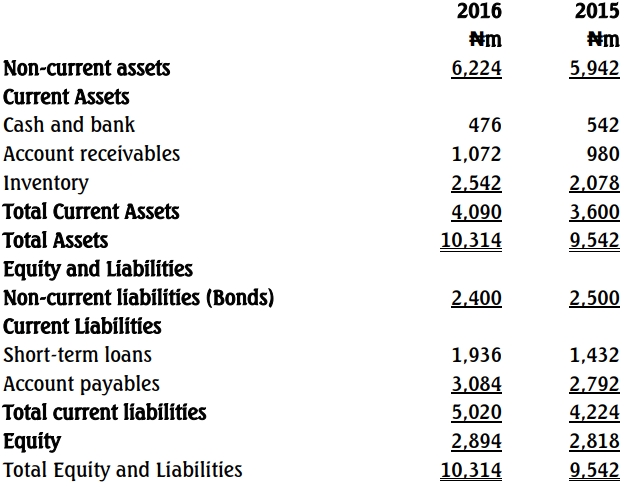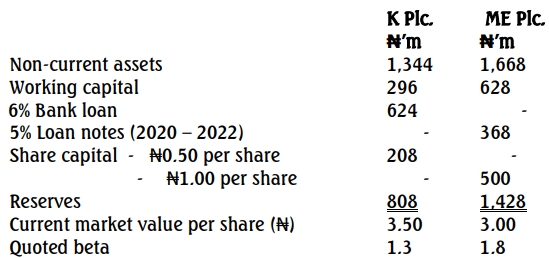- 6 Marks
CR – Nov 2024 – L3 – Q5a – Financial Analysis and Investment Evaluation
Compute financial ratios for Nsawkaw PLC to evaluate its financial performance for investment recommendation.
Question
Nsawkaw PLC (NK), a gold processing and trading company, has been identified by Djaraye Private Equity Fund (DPEF) as a target for long-term equity investment. As a financial consultant of DPEF, you have been tasked to evaluate the integrated financial condition of NK and make an investment recommendation.
Below are the summarised versions of NK’s Consolidated Financial Statements for the year ended June 30, 2024 (together with its comparative period):
Summarised Consolidated Statement of Profit or Loss for the year ended 30 June 2024
| 2024 (GH¢000) | 2023 (GH¢000) | |
|---|---|---|
| Revenue | 2,538,000 | 2,125,000 |
| Operational expenses | (1,909,100) | (1,592,900) |
| Interest costs | (186,700) | (157,250) |
| Taxation | (234,000) | (198,500) |
| Profit after tax | 208,200 | 176,350 |
| Other comprehensive income | 17,900 | 10,550 |
| Total comprehensive income | 226,100 | 186,900 |
Summarised Consolidated Statement of Changes in Equity for the year ended 30 June 2024
| Equity Holders of the Parent (GH¢000) | Non-controlling Interests’ Equity (GH¢000) | Total Equity (GH¢000) | |
|---|---|---|---|
| 2024 | |||
| Balances b/d | 457,200 | 65,600 | 522,800 |
| Total comprehensive income | 190,800 | 35,300 | 226,100 |
| Dividends | (110,000) | (8,700) | (118,700) |
| Balances c/d | 538,000 | 92,200 | 630,200 |
| 2023 | |||
| Balances b/d | 355,000 | 46,650 | 401,650 |
| Total comprehensive income | 160,500 | 26,400 | 186,900 |
| Dividends | (58,300) | (7,450) | (65,750) |
| Balances c/d | 457,200 | 65,600 | 522,800 |
Summarised Statement of Financial Position as at 30 June 2024
| 2024 (GH¢000) | 2023 (GH¢000) | |
|---|---|---|
| Non-current assets | ||
| Property, plant, and equipment | 718,000 | 657,000 |
| Others | 156,000 | 99,000 |
| Total Non-current assets | 874,000 | 756,000 |
| Current assets | ||
| Trade receivables | 140,000 | 121,000 |
| Others | 236,500 | 123,050 |
| Total Current assets | 376,500 | 244,050 |
| Total Assets | 1,250,500 | 1,000,050 |
| Total Equity and Liability | 1,250,500 | 1,000,050 |
Additional information:
- The total number of equity shares outstanding was 1.2 million and 1.4 million at 30 June 2023 and 30 June 2024 respectively.
- Other comprehensive income attributable to non-controlling interests for the years ended 30 June 2023 and 2024 amounted to GH¢8.05 million and GH¢9.6 million respectively.
- Non-current liabilities at 30 June 2023 and 30 June 2024 amounted to GH¢250,800 and GH¢308,510 respectively.
- The following metrics have been gleaned from NK’s published sustainability reports across the two years:
| Metric | 2024 | 2023 |
|---|---|---|
| Scope 1 & 2 carbon emissions (tonnes of CO2) | 650 | 780 |
| Scope 3 carbon emissions (tonnes of CO2) | 2,400 | 2,380 |
| Women in senior management (%) | 21 | 16 |
| Total recordable injury frequency rate (TRIFR) per 100 full-time workers | 3.3 | 4.1 |
The scope and definitions of the above sustainability measures have remained materially unchanged across the two years.
Required:
Compute the following ratios for the years ended 2024 & 2023:
- Operating profit margin
- Return on parent’s equity
- Earnings per share
- Current ratio
- Trade receivables days
- Total liabilities to total assets %
Find Related Questions by Tags, levels, etc.
Report an error







